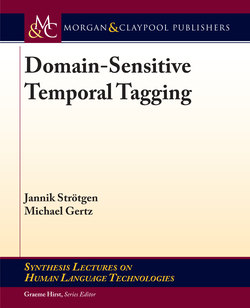Читать книгу Domain-Sensitive Temporal Tagging - Jannik Strötgen - Страница 7
На сайте Литреса книга снята с продажи.
ОглавлениеContents
List of Figures
List of Tables
Preface
Acknowledgments
1 Introduction
1.1 The Task of Temporal Tagging
1.2 Application Examples Exploiting Temporal Tagging
1.3 Summary of the Chapter
2 The Concept of Time
2.1 Key Characteristics of Temporal Information
2.2 Temporal Expressions in Documents
2.3 Realizations of Temporal Expressions
2.4 Summary of the Chapter
3 Foundations of Temporal Tagging
3.1 Annotation Standards
3.2 Evaluating Temporal Taggers
3.3 Research Competitions
3.4 Annotated News-style Corpora
3.5 Summary of the Chapter
4 Domain-sensitive Temporal Tagging
4.1 Temporal Tagging of News-style Documents
4.2 The Concept of a Domain
4.3 Annotated Non-news-style Corpora
4.4 Characteristics of Different Domains
4.4.1 News-style Documents
4.4.2 Narrative-style Documents
4.4.3 Colloquial-style Documents
4.4.4 Autonomic-style Documents
4.4.5 Further Domains and Summary
4.5 Comparative Corpus Analysis—Challenges for Domain-sensitive Temporal Tagging
4.6 Strategies for Domain-sensitive Temporal Tagging
4.7 Summary of the Chapter
5 Techniques and Tools
5.1 Overview of Approaches to Temporal Tagging
5.2 Overview of Existing Temporal Taggers
5.2.1 TIPSem—Exploiting Semantic Information
5.2.2 HeidelTime—Rule-based, Multilingual, Domain-sensitive
5.2.3 SUTime—Rule-based, Stanford CoreNLP Component
5.2.4 UWTime—Semantic Parsing of Time Expressions
5.2.5 Comparison and Evaluation Results
5.3 The Value of Domain-sensitive Temporal Tagging
5.4 Approaches to Subtasks and Related Tasks
5.5 Highly Multilingual Temporal Tagging
5.6 Summary of the Chapter
6 Summary and Future Research Directions
6.1 Summary
6.2 Future Directions
Bibliography
Authors’ Biographies
Index
